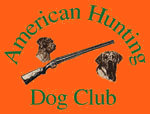

Copyright © 1996-2024, The
American Hunting Dog Club
The AHD test will evaluate thirteen (13) areas of competence: nose, desire, cooperation, obedience, search, pointing/flushing, steadiness on game, retrieve of shot bird, retrieve of duck, retrieve by drag, heeling, stopping on command, and remaining where left. In addition, the dog will be evaluated for coat, conformation, temperament and reaction to gunfire.
One of the first commands a dog should learn is to heel on lead. Heeling on lead may be followed by heeling off lead. To test heeling, a fifty (50) yard slalom course consisting of ten (10) 30-inch wide gates will be set up. The slalom course may be natural or consist of a combination of natural and staked gates. The course should have at least two sharp direction changes of at least 90 degrees; one left and one right. If convenient, the slalom course may end at the blind for retrieving. Heeling off lead is more advanced work and will be judged accordingly. The hunter will be required to carry a gun.
The AHD must learn to remain quietly where he is left. There are many situations encountered while hunting and other activities that require the handler to leave his dog in a safe spot for a short period of time. In most situations, the hunter will return to the dog, while in other situations, he will want to call the dog to him. In addition, this is another way of evaluating a dog for gun shyness.
The dog will be placed standing, sitting or down at the handler's discretion. The handler will then be handed a gun and two blank shells and asked to walk out of sight of the dog. While out of sight, the hunter will fire two (2) shots, spaced a few moments apart, and return to the dog.
A single marked retrieve is required. The dog must be steady to wing but is allowed to break on shot. He must bring the bird to land, but delivery to hand is not required. Any undue damage to the bird will fail the dog in retrieving and will be noted on his test record.
A spread of eight to ten (8-10) decoys will be set in front of the blind. The dog will be placed outside the blind so that he can mark the flight and the fall of the bird. The retrieve should be at least fifty (50) yards. If there is heavy vegetation the distance may be shortened. The duck will be thrown and while it is in the air the handler will shoot at it. The handler will send the dog to retrieve.
The AHD search sequence will last for twenty minutes. The dog should search the area with purpose and drive. He should demonstrate that he has some knowledge of the use of the wind. The handler is allowed to help the dog to cover likely ground with voice, whistle, or hand signals. Handlers of flushing dogs will be given considerable freedom in commanding the dog to keep it within gun range with no fault. The stop on command test will be judged during the search.
After the apprentice hunting dog has established point a single command is permissible. Pointing will be judged as described under items judged throughout.
As young dogs may become over-exuberant at times in the presence of game, the hunter will be given considerable freedom to issue commands in order to allow the gunner(s) and himself to get within gun range for the flush.
The dog will not be penalized for commands before the shot, but must remain steady through the flush, flight, and shot.
All birds shot must be retrieved. However, delivery to hand is not required. See "Items Evaluated in All Tests."
The retrieve by drag is a test of the dog's willingness to follow the trail of game and retrieve the game for which it was sent. He does not need to stay glued to the trail as a hound would, but must clearly demonstrate that he is using the scent trail to get to the game.
Any game used for the drag must be old. With the dog and handler out of sight, a trail will be laid starting in open cover and ending out of sight of the handler, judges, and gallery. There must be at least one bend in the course within sight of the judges remaining with the hunter, and one in sight of the judge who lays the drag. Where possible at least half of the trail should be out of the handler's sight. Let the terrain dictate the drag distance. Improper handling of the game will fail the dog in the drag and will be noted on the test record. If he returns to the handler without the game, he is allowed one (1) restart unless the dog finds the game and refuses to retrieve. Game must be delivered to within easy reach of handler.
Desire will be judged in all phases of the test as described in the session "Items Evaluated in All Tests."
The AHD must demonstrate that he has mastered the essentials of obedience: whoa, heel, stay; and, that he accepts some guidance from the handler.